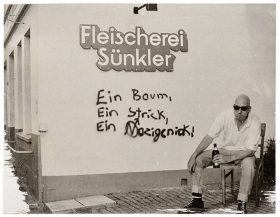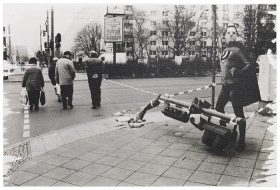Joachim Seinfeld’s HeimatReisen (HomelandTravels)
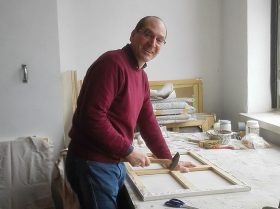
Joachim Seinfeld at work in his atelier in the former broadcasting station in Berlin; Jewish Museum Berlin, photo: Michaela Roßberg
The wonderful thing about Berlin for me as an historian is that there’s something around every corner waiting to wow me or get my “history heart” to skip a beat. I was able to get to know yet another spot this year when I interviewed Joachim Seinfeld in his atelier in the old broadcasting station in the Berlin Treptow-Köpenick district. We talked about his HeimatReisen (HomelandTravels) project for the art vending machine at the Jewish Museum Berlin (further information on the art vending machine on our website).
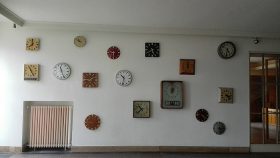
The station’s entryway was built with marble tiles from the New Reich Chancellery; Jewish Museum Berlin, photo: Michaela Roßberg
The broadcasting station on Nalepastrasse is a unique place: Beginning in 1956, programming across the former GDR was produced and broadcast from there. The public broadcasting system, established following German reunification, took over this work in 1991 and then, after several changes in ownership, the building became a place for artists from around the world to establish their ateliers.
Joachim, your photo series – available to visitors in the art vending machine – consists of a number of images depicting you in various locations around Germany. Why, of all your work, these images for the vending machine?
In 2006, I did a photo series about Poland. In 2011, I thought to do something similar about Germany. So I wanted to do it anyway, and I chose the images most interesting to me.
So are the places in the images you yourself are part of also situations from your life?
Poland, Germany and Italy are countries I’ve spent extended periods of time in and I attach importance to. I wanted to create a trilogy for these countries with the photo series. The images are largely connected to places I’ve spent a long time in, or nearby. I’m from Munich and lived in Italy, then Oldenburg, and worked two years in Poland. Now I’ve been a long time in Berlin. The altered or modified photos of the places in HeimatReisen play with concepts and cliches of a supposedly typical Germany.
Is the takeaway with the title, HeimatReisen, that you don’t feel at home in these places?
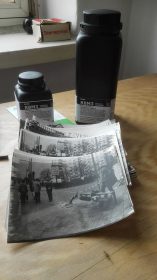
Jars of photo emulsion and a few examples from HeimatReisen – Berlin Friedrichshain; Jewish Museum Berlin, photo: Michaela Roßberg
Yes. When I think about the subject of homeland, I always come back to the word, yurt. It’s the Turkish word for homeland, and the yurt, tent, which nomads use for housing, comes from this word. It’s a home you can take with you in your travels. In this sense, HeimatReisen.
The only place I really feel at home is in the mountains – the landscape of my childhood. Homeland for me is more a feeling than a particular place. It has to do with my life situation. And it for sure isn’t connected to a feeling of national pride.
Would your understanding of “homeland” be different for you if you didn’t live in Germany?
Quite possibly. The problem is that the German understanding has been completely discredited due to German history and misappropriation of the word. There’s also a positive connotation that has more to do with being and feeling at home. I’m much more comfortable with this than, for example, the Italian word for homeland, patria. That conjures up images of the goosestep in my mind.
Other countries often have a more natural connection to the idea of homeland. Is this a “German problem?”
To a degree, yes, though I personally have a problem with it in other countries’ contexts, too, especially when the concept of homeland approaches the realm of patriotism. I’m of the opinion that the word “patriotism” is itself too closely tied to thinking that one’s own country is better than another’s, and you’re better than someone else. These days, when travel is so much easier and you can experience so many more perspectives, I don’t think we need to be constrained to this idea of homeland. I think we can also find our identity elsewhere.
What do you want to say with your work? As a viewer, I asked myself: What do you, for example, want to say to me with the Oldenburg work? Something about how many neo-Nazis are in this city?
The work contains many facets and discussion points that I address with irony. HeimatReisen also means the images can contain things that I as a traveler or observer could have captured. The Oldenburg staging is of course bathed in cliché. I generally like to do that, but it’s always relevant either to history or current developments. For example, Oldenburg in addition to Weimar had a Nazi administration before 1933, and the region was a playground for their ilk in the 1990s.
But what should a viewer of your images be thinking? Do you have something particular in mind?
That’s not how art works. You don’t make art because people should see something in particular. Then it’s didactic pedagogy or agitprop. You just make art shaped by your thoughts and ideas, and you’re lucky should people happen to get from it what you intended. The artist has to accept the risk that the viewer may have a completely contrary interpretation.
That explains why I’m not an artist – that’d make me too insecure.
You don’t work completely blind; you get feedback a number of ways: If you’ve been making art for 20 years and no one wants to look at it, that’s also a kind of reaction.
Why are you as yourself always worked into the images?
First of all, it’s unbelievable fun to make theater out of it. Second of all, I’m of the opinion that a person is shaped by all aspects of a society. So why should I use another person in the staging? There are exemplary images of this in HeimatReisen and it’s pretty irrelevant who’s pictured in those. Of course I bring individual aspects into the work, for example in “Super Jew” in Friedrichhain. The “Super Jew” crosses against the light, which is actually a pointless action, but he’s very satisfied nonetheless. Sometimes you take yourself too seriously (laughs).
Is it satisfying for you as an artist when your work is available for 6 euros in a museum vending machine?
Sure. I think the idea of an art vending machine is superb. Art has to be for everyone. It’s not just for the wealthy, but should be accessible for all people – also outside a museum.
Michaela Roßberg recommends the wonderful milk bar in the broadcasting station. The small cafeteria is also open to visitors.
Further information about Joachim Seinfeld: http://joachimseinfeld.com
